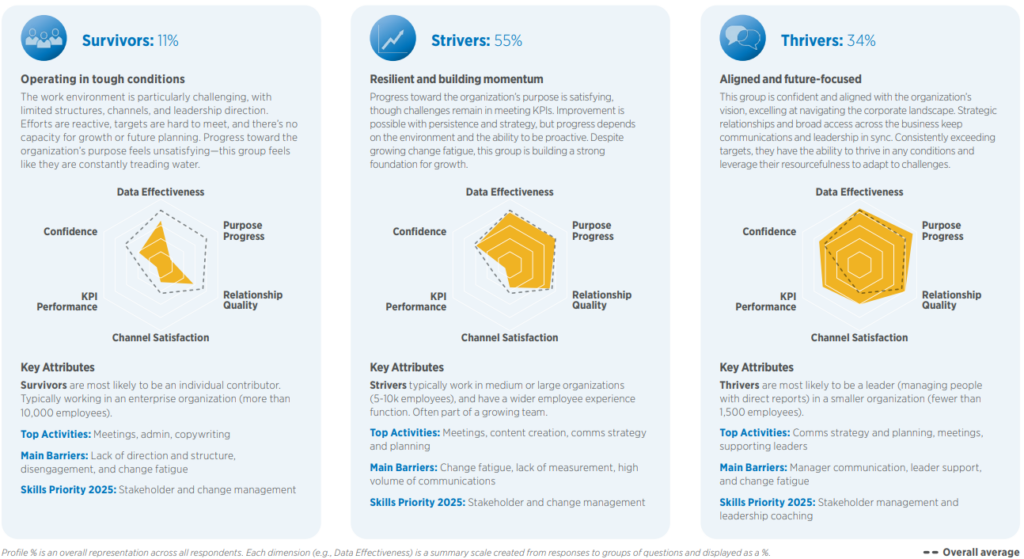STATE OF THE SECTOR 2024/25 REPORT: TOWARDS MORE STRATEGIC, DATA-DRIVEN AND PEOPLE-CENTRED INTERNAL COMMUNICATIONS

13 May 2025

In 2024, internal communication professionals were faced with an uncertain context: the integration of artificial intelligence was still in its infancy, there was a fragile alignment between HR and internal communication, and the tools were often ill-adapted...
The State of the Sector 2024/25 study explores the central role of the communicator in driving major organisational transformations and identifies the key levers for enhancing the employee experience. Here are the key findings.
Three profiles of in-house communicators: where do you fit in?
Pour mieux cerner les dynamiques actuelles de la communication interne, le rapport propose une typologie des professionnels du secteur. Trois profils-types émergent, définis selon leur niveau d’influence et leur impact organisationnel. Se reconnaître dans l’un d’eux permet d’identifier plus clairement ses forces, ses défis… et les leviers pour progresser.
- Survivant (Survivor) – 11 % des répondants
Vous évoluez dans un environnement très structuré, parfois rigide, où la marge de manœuvre est limitée. Confronté à de nombreux obstacles (manque de moyens, faible reconnaissance, processus lourds), vous êtes majoritairement mobilisé sur des tâches tactiques, avec peu de latitude pour un rôle stratégique.
- Lutteur (Striver) – 55 % des répondants
À mi-chemin entre la stratégie et l’opérationnel, vous jonglez au quotidien avec des attentes multiples. Vous souffrez d’un manque d’adhésion de la part des dirigeants, d’une reconnaissance fluctuante de votre rôle, et de l’essoufflement causé par des changements constants. Votre mission nécessite un engagement constant pour faire exister la communication interne.
- Prospère (Thriver) – 34 % des répondants
Votre fonction est bien positionnée au sein de l’organisation. Vous vous appuyez sur les données pour piloter vos actions, entretenez des relations solides avec les décideurs, et êtes aligné sur les priorités stratégiques de l’entreprise. Cette posture vous permet d’agir comme un véritable levier de transformation interne.
Cette grille de lecture invite chaque communicant à se situer pour mieux comprendre son environnement, ajuster ses priorités… et viser, à terme, une position de Prospère (Thriver).
Découvrez plus de détails dans le rapport complet (en anglais)
The 7 major trends reshaping internal communication
Le rapport State of the Sector 2024/25 identifie les tendances qui orienteront le métier des communicants internes, de l’impact de l’IA à l’évolution des objectifs stratégiques.
- La communication interne s’affirme comme fonction stratégique
Longtemps perçue comme un simple rôle de soutien, la communication interne s’impose aujourd’hui comme un levier clé de transformation. Elle soutient la communication managériale, nourrit l’expérience collaborateur et accompagne les mutations profondes des organisations.
Mais un frein persiste : l’intégration de l’intelligence artificielle reste embryonnaire, faute de stratégie claire, de formations adaptées et de gouvernance établie.
- L’intelligence artificielle : des promesses à concrétiser
L’adoption de l’IA en communication interne reste modérée : seules 36 % des organisations disposent de directives précises, et 38 % n’ont encore aucune gouvernance formelle.
Selon l’Observatoire du travail hybride 2024 d’Arctus, près de 50 % des entreprises n’ont mis en place aucune action d’accompagnement des usages liés à l’IA.
Malgré des gains d’efficacité notables, l’IA soulève des préoccupations majeures : sécurité des données, perte d’authenticité, transparence… Autant de défis à relever pour rassurer et former.
- Une fatigue du changement qui freine la dynamique
44 % des communicants identifient la fatigue liée aux transformations successives comme un obstacle majeur.
Ce phénomène est aggravé par une communication managériale jugée souvent insuffisante et des visions stratégiques floues. Dans ce contexte, les communicants peinent à trouver un équilibre entre exécution et rôle stratégique, tout en restant sous forte pression.
- Clarifier l’objectif de la communication interne devient vital
Les priorités évoluent : alignement stratégique, culture d’entreprise, sentiment d’appartenance, agilité… Pourtant, seuls 23 % des professionnels se disent satisfaits de leur capacité à écouter véritablement les collaborateurs.
Pour renforcer l’impact, il devient essentiel de définir clairement les ambitions de la communication interne et d’en démontrer les bénéfices concrets.
- Mesurer, encore et toujours
La légitimité passe par la mesure de l’impact : engagement, sensibilisation stratégique, évolution des comportements… Pourtant, seuls 60 % des communicants s’appuient systématiquement sur des données pour formuler leurs recommandations.
L’édition 2023 de l’Observatoire de l’intranet rappelle que, si la culture de la mesure progresse, le partage des données reste encore trop limité — notamment entre management et collaborateurs.
- Investir pour mieux convaincre
Aujourd’hui, la moitié des communicants disposent de budgets dédiés à leurs actions — un avantage stratégique pour démontrer leur valeur.
En cas de financement supplémentaire, les priorités iraient vers :
- L’amélioration des technologies internes,
- L’intégration progressive de l’IA générative (prévue par 2/3 des entreprises à horizon 2 ans),
- La formation des dirigeants à une communication plus impactante.
- Personnaliser et renforcer l’écoute
Malgré le succès des blogs de dirigeants, des événements managériaux ou des communications ciblées, la personnalisation reste marginale : seuls 30 % des communicants sont satisfaits de leur capacité à diffuser du contenu véritablement personnalisé.
Moins de 40 % ont mis en place une stratégie structurée d’écoute des collaborateurs en 2024.
L’Observatoire de l’intranet 2023 souligne également une sur dépendance aux évaluations quantitatives, au détriment d’une approche qualitative plus fine.
What are the priorities for internal communicators in 2025?
À la lecture du rapport State of the Sector 2024/25, un constat s’impose : la communication interne est à un tournant stratégique.
Alors que la structuration de l’usage de l’intelligence artificielle, l’investissement dans l’écoute active des collaborateurs et la montée en compétences des équipes s’imposent comme des chantiers prioritaires, deux axes majeurs ressortent pour renforcer l’impact et la reconnaissance de la fonction.

1. Ancrer la communication interne dans la stratégie d’entreprise
La communication interne ne peut plus être isolée : elle doit s’intégrer pleinement à la dynamique globale de l’organisation.
Cela implique de :
- Renforcer les liens avec les parties prenantes clés (direction, RH, managers, métiers),
- Diffuser des messages opportuns, pertinents et alignés avec les priorités stratégiques,
- Favoriser des conversations authentiques à tous les niveaux pour créer une expérience collaborateur cohérente, fluide et humaine.

2. Adopter une approche centrée sur les données
Dans un contexte où la crédibilité passe par la preuve, il devient indispensable de :
- Etayer ses recommandations avec des données concrètes,
- S’appuyer sur les indicateurs les plus pertinents pour l’entreprise : engagement, évolution des comportements, performance collective,
- Développer une culture de la mesure pour démontrer la valeur ajoutée de chaque action de communication.
La profession de communicant interne gagne en complexité et en influence. Les communicants qui réussiront seront ceux capables d’aligner vision stratégique, maîtriser les outils et incarner un rôle moteur dans la transformation culturelle et organisationnelle.
Want to go further?
L’étude State of the Sector 2024/25 a été conduite entre août et décembre 2024 à l’aide d’une méthodologie mixte, combinant approches qualitatives et quantitatives :
- Plus de 2 000 répondants à une enquête en ligne,
- Un comité de pilotage de 8 experts,
- Un atelier « Dashboard Discussion » réunissant 20 participants,
- Et 6 groupes de discussion impliquant 37 professionnels de la communication interne.
Chez Arctus, nous accompagnons les organisations à chaque étape de la transformation de leur communication interne : diagnostic, stratégie, gouvernance, adoption des nouveaux outils et conduite du changement.
Vous avez un projet ou des défis à relever ?
Contactez-nous pour échanger sur vos enjeux et bâtir ensemble une expérience collaborateur alignée, engageante et durable.

Founder of Arctus, Partner
Founder and director of Arctus, Isabelle is also an author and speaker. Since 2007, she has shared her perspective and sheds light on the internal transformations that organizations are going through through studies and observatories such as the Hybrid Work and Digital Management Observatory, the Intranet & Digital Working Observatory or the creativity. She is also an administrator and an active member of AFCI, the French Association of Internal Communication Professionals.




